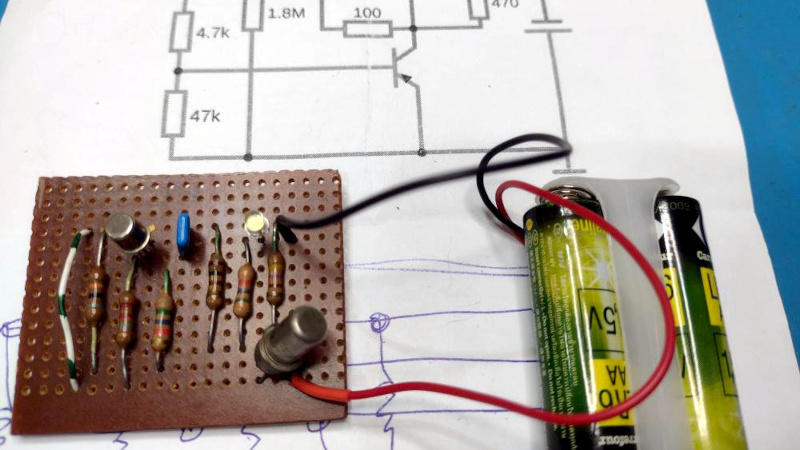If you’ve worked with germanium transistors, you’ll know that many of them have a disappointingly low maximum frequency of operation. This has more to do with some of the popular ones dating from the earliest years of the transistor age than it does to germanium being inherently a low frequency semiconductor, but it’s fair to say you won’t be using an OC71 in a high frequency RF application. It’s clear that [Ken Yap]’s project is taking no chances though, because he’s using a vintage germanium transistor at a very low frequency — 1 Hz, to be exact.
The circuit is a simple enough phase shift oscillator that flashes a white LED, in which a two transistor amplifier feeds back on itself through an RC phase shift network. The germanium part is a CV7001, while the other transistor is more modern but still pretty old these days silicon part, a BC109. The phase shift network has a higher value resistor than you might expect at 1.8 MOhms, because of the low frequency of operation. Power meanwhile comes from a pair of AA cells.
We like this project not least for its use of very period passive components and stripboard to accompany the vintage semiconductor parts. Perhaps it won’t met atomic standards for timing, but that’s hardly the point.
This project is an entry in the 2025 One Hertz Challenge. Why not enter your own second-accurate project?
















I would have used a little incandescent lamp instead of the white LED,
because it’s prettier/warmer/smoother looking.
Maybe via an switching transistor or an electro-mechanical relay, if needed to drive it.
I doubt the “phosphor afterglow” mentioned is actually happening. I measured some white LEDs some time ago. The blue excitation LED follows the electrical waveform (100 nanosecond fall time in my case). The yellow “afterglow” has a time constant of 2 microseconds. This was in the context of building a strobe for high photography that was quieter and less lethal than an air-gap flash.
I have fairy lights, they definitely have an afterglow, although I don’t know if it is in the phosphor or in the power supply.
Easy to determine with a shunt resistor and an oscilloscope. The money’s definitely on the power supply though.
For many years the go-to for timebase generation was the unijunction transistor. You can make a nice sawtooth generator relaxation oscillator with just a battery, UJT, three resistors and one capacitor. The linearity of the ramp is quite good.
Here’s an example: https://www.tutorialspoint.com/pulse_circuits/pulse_circuits_ujt_as_relaxation_oscillator.htm
Ah yes, the mythical unjunction transistor.
I once had a chat with an employee of an electronic shop about it. Must bern 20 years ago or so.
That transistor was considered somewhat odd and obscure, at least where I live.
I guess it must been common over the big pond, though.
Uni junction transistors were common in the 1970s to make pulse or ramp oscillators in designs in UK publications, but were largely made obsolete by the coming of the 555 timer I.C.
When I started in electronics, transistors were new technology. To read them being being described as ancient leaves me feeling a bit old(er).